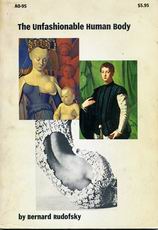

|
|

The Unfashionable Human Body
Rudolfsky, Bernard
Publisher: Doubelday AnchorYear Published: 1973 Price: $18.55 Resource Type: Book Cx Number: CX7119 A discussion of apparel, in the broadest sense of the word, and how it has reflected and shaped attitudes to the human body. Abstract: Rarely do you find a book that is thought-provoking and entertaining, amusing and serious, wise and easy-to-understand, all at the same time. But Bernard Rudolfsky's The Unfashionable Human Body is such a work. It's a discussion of apparel - in the broadest sense of the word - and how it has reflected and shaped attitudes to the human body (as well as having often been literally used to shape the body itself). The text is accompanied by scores of compelling and fascinating illustrations. The overall message is one of the continual distortion and mutilation of the body and bodily functions, the atrophy of sense, the unbalancing of natural rhythms. The argument is powerful and well-presented, the author's sweep of knowledge and range of argument tremendously impressive. While he points to examples of happy creativity and comfort in styles of dress, the bulk of the book necessarily concerns the length to which various societies have gone to warp and harm the body. The result, even though the main function of the book is to record and describe, not to polemicize and convert, is to present an indictment of predominant attitudes to apparel, and to indicate what is possible, and necessary, to change. He discusses early Christian attitudes to sex and clothing, and traces the crucial relationship between the two throughout history. It's interesting that some Christian paintings depicted Adam and Eve as having the genitals of both sexes simultaneously before the fall, while others conceived of them as having no genitals at all. The development of ideas of modesty is fascinating. Women in certain New Hebrides tribes, for example, must have properly done hair, but wear no clothes. Some cultures force women to wear masks or veils. Others consider it unimportant to cover the breasts, while in Victorian England there were charts that showed precisely, in inches, how much of a girl's legs had to be covered at each age. (Women have nearly always been subjected to greater restrictions in dress, and to more outrightly deforming apparel, than men.) In our time, the male genitals are de-emphasized as much as possible in clothing (although tight blue jeans are changing that to some extent); in other cultures, however, variations on the codpiece have been an essential item of dress. Notable for their emphasis of the penis are sixteenth century Italy, and the New Hebrides, where "the well-dressed man wraps his penis in cloth to form an impressive bundle, held in place with a leather belt." Another of Rudolfsky's points is the decline of certain senses, especially taste and smell, which has put a greater stress on visual sexual stimulation, and a great downplaying of erotic excitement through smelling and tasting. One of the most compelling sections of the book is his discussion of the decoration and deliberate deformation of the body, ranging from tattooing to devices to deform the shape of the head, to corsets (which displace the internal organs) to the foot-binding of pre-revolutionary China. Rudolfsky points out that most of our own feet are deformed by our shoes: for example, the two big toes should be parallel and touching when placed side by side; with most of us, however, they curve inward. According to the most popular shape of shoes, the big toe should be in the middle of the foot, not on the side. Attitudes to hair are another fascinating chapter in human history. The battle against long hair in the recent past is still familiar to most of us (and is not yet over, either); we're probably less familiar with the dramatic changes through the ages; each fashion, of course, being the only one that was socially acceptable in its time. Pants and skirts have undergone phenomenal modifications. It's interesting that many societies did not differentiate between male and female clothing, and also that throughout history, men have probably worn skirts more than women, while women have worn trousers more. The trouser crease is a recent invention; as Rudolfsky says, "its sole function seems to consist of reminding us that trouser legs are not for bending: to the tailor's mind the perfect gentleman is a stiff-legged man." And so it goes. The Unfashionable Human Body is a journey, simultaneously hilarious and shocking, through the vagaries of fashion, and a must for anyone who is interested to sexuality, sensuality, and the liberation of the body. - Reviewed by Ulli Diemer Table of Contents Foreword The birth of clothes Anatomy of modesty A portfolio of monsters The fashionable body The decorative arts Cut and dry cuts Dress reform and reform dress Sartoriasis Garments for two Clothes and the artist Text references Index Photographers' credits Subject Headings |